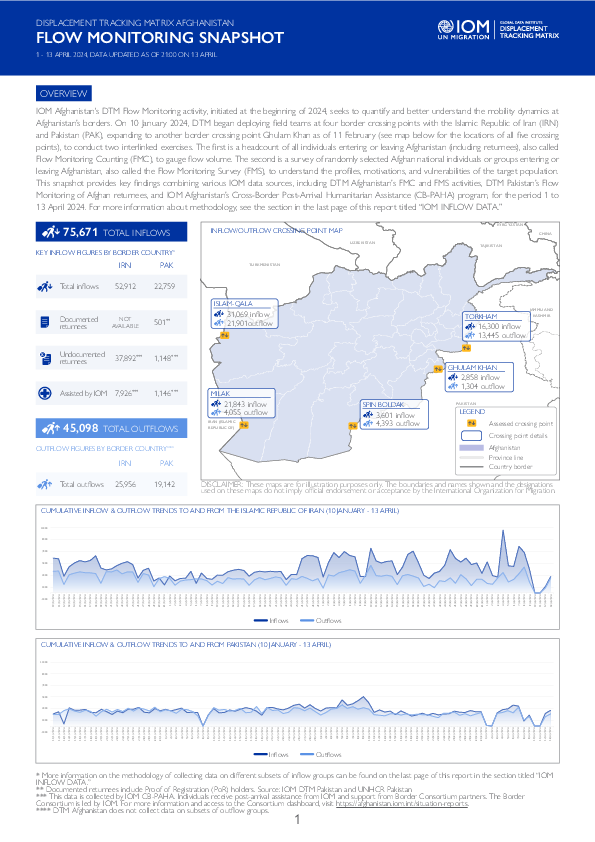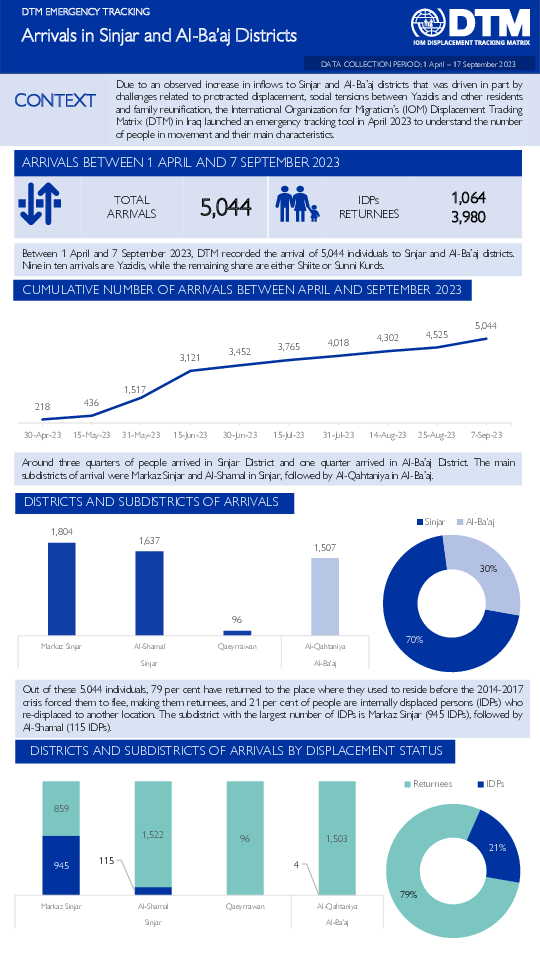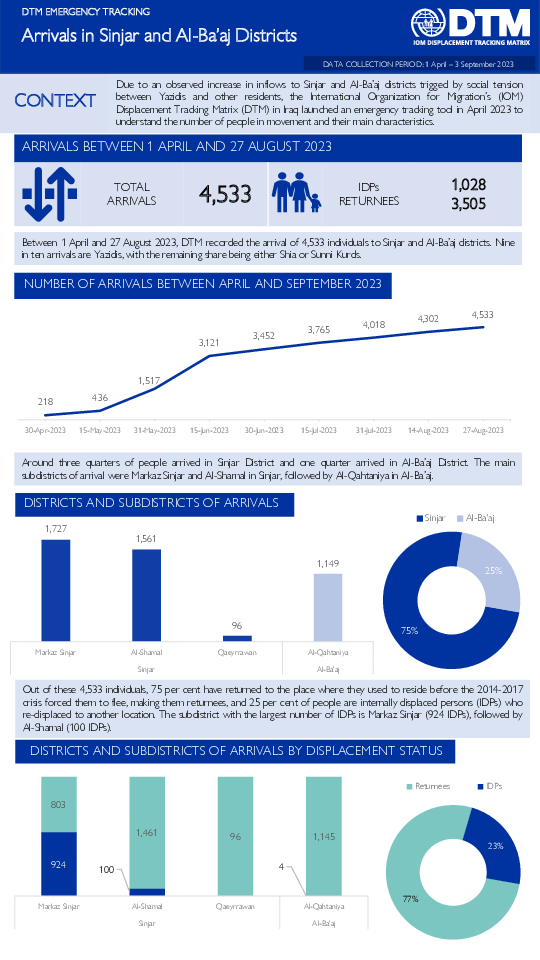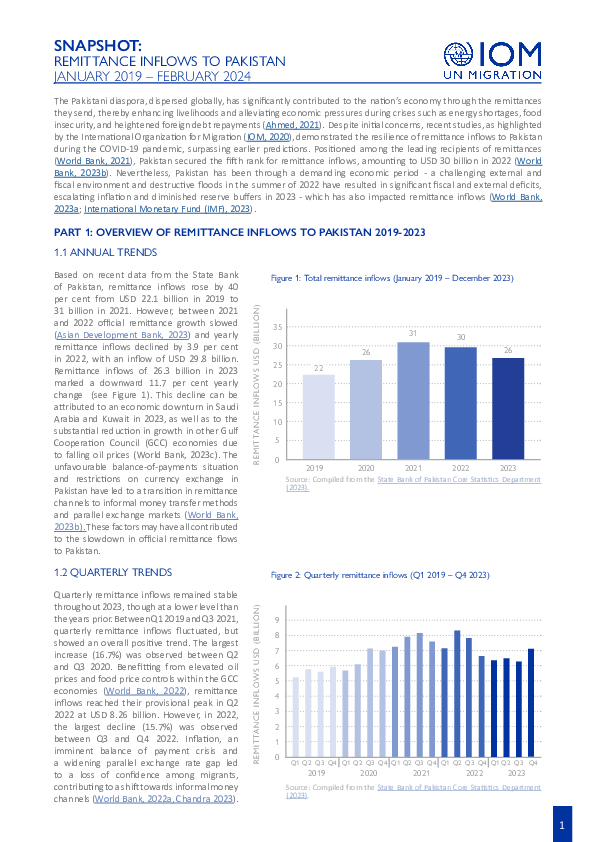-
Countries
-
Data and Analysis
-
Special Focus
-
Crisis Responses

Contact
IraqDTM@iom.int
Language
English
Location
Iraq
Period Covered
Apr 01 2023
Oct 01 2023
Activity
- Mobility Tracking
- Event Tracking
Due to an observed increase in inflows to Sinjar and Al-Ba’aj districts that was driven in part by challenges related to protracted displacement, social tensions between Yazidis and other residents and family reunification, the International Organization for Migration’s (IOM) Displacement Tracking Matrix (DTM) in Iraq launched an emergency tracking tool in April 2023 to understand the number of people in movement and their main characteristics.

Contact
DTMAfghanistan@iom.int
Language
English
Location
Afghanistan
Period Covered
Apr 01 2024
Apr 13 2024
Activity
- Survey
- Flow Monitoring Survey
- Flow Monitoring
IOM Afghanistan's DTM Flow Monitoring activity, initiated at the beginning of 2024, seeks to quantify and better understand the mobility dynamics at Afghanistan’s borders. On 10 January 2024, DTM began deploying field teams at four border crossing points with the Islamic Republic of Iran (IRN) and Pakistan (PAK), expanding to another border crossing point Ghulam Khan as of 11 February (see map below for the locations of all five crossing points), to conduct two interlinked exercises. The first is a headcount of all individuals entering or leaving Afghanistan (including returnees), also called Flow Monitoring Counting (FMC), to gauge flow volume. The second is a survey of randomly selected Afghan national individuals or groups entering or leaving Afghanistan, also called the Flow Monitoring Survey (FMS), to understand the profiles, motivations, and vulnerabilities of the target population. This snapshot provides key findings combining various IOM data sources, including DTM Afghanistan’s FMC and FMS activities, DTM Pakistan’s Flow Monitoring of Afghan returnees, and IOM Afghanistan’s Cross-Border Post-Arrival Humanitarian Assistance (CB-PAHA) program, for the period 1 to 13 April 2024. For more information about methodology, see the section in the last page of this report titled “IOM INFLOW DATA.”

Contact
IraqDTM@iom.int
Language
English
Location
Iraq
Period Covered
Apr 01 2023
Sep 17 2023
Activity
- Mobility Tracking
- Event Tracking
Due to an observed increase in inflows to Sinjar and Al-Ba’aj districts that was driven in part by challenges related to protracted displacement, social tensions between Yazidis and other residents and family reunification, the International Organization for Migration’s (IOM) Displacement Tracking Matrix (DTM) in Iraq launched an emergency tracking tool in April 2023 to understand the number of people in movement and their main characteristics.

Contact
IraqDTM@iom.int
Language
English
Location
Iraq
Period Covered
Apr 01 2023
Sep 03 2023
Activity
- Mobility Tracking
- Event Tracking
Due to an observed increase in inflows to Sinjar and Al-Ba’aj districts trigged by social tension between Yazidis and other residents, the International Organization for Migration’s (IOM) Displacement Tracking Matrix (DTM) in Iraq launched an emergency tracking tool in April 2023 to understand the number of people in movement and their main characteristics.

Contact
IraqDTM@iom.int
Language
English
Location
Iraq
Period Covered
Apr 01 2023
Aug 20 2023
Activity
- Mobility Tracking
- Event Tracking
Due to an observed increase in inflows to Sinjar and Al-Ba’aj districts trigged by social tension between Yazidis and other residents, the International Organization for Migration’s (IOM) Displacement Tracking Matrix (DTM) in Iraq launched an emergency tracking tool in April 2023 to understand the number of people in movement and their main characteristics.
Contact
dtmuganda@iom.int vwabwire@iom.in
Location
Uganda
Activity
- Mobility Tracking
- Event Tracking
- Baseline Assessment
Period Covered
Mar 10 2024 -Mar 29 2024
In March, the impacts of the hazards affected 10,390 individuals (2,387 households), with 426 people from 91 households were internally displaced. Children below the age of 18 were the most affected age group (67%), followed by adults (18-64) at 30% and elderly above 64 (3%). Notably, more than half of affected people were female (62%).
A more detailed version of this dataset, including the number of the vulnerabilities, is available. To get access, kindly click on the 'Request Access' button.
Population Groups
IDPs
Residents
Survey Methodology
Unit of Analysis Or Observation
Admin Area 2
Admin Area 3
Community
Type of Survey or Assessment
Key Informant
Keywords
Geographical Scope Partial Coverage
Administrative boundaries with available data
The current dataset covers the following administrative boundaries

Contact
rdhroapsupport@iom.int, dtmremapsupport@iom.int
Language
English
Location
Pakistan
Period Covered
Jan 01 2019
Feb 29 2024
Activity
- Other
This report on remittance inflows to Pakistan from 2019 to 2024 details the fluctuating trends in money sent home by the Pakistani diaspora. The report highlights the economic impact of these financial transfers. Initially, remittances grew significantly, reaching USD 31 billion in 2021, but this was followed by a decline, with 2023 seeing a drop to USD 26.3 billion, largely due to economic issues in the Gulf Cooperation Council countries and restrictive financial policies in Pakistan. Despite these challenges, remittance inflows remained a critical source of foreign exchange and economic stability, particularly during crises such as the COVID-19 pandemic and the 2022 floods.

Contact
dtmlebanon@iom.int
Language
English
Location
Lebanon
Period Covered
Oct 10 2023
Apr 16 2024
Activity
- Mobility Tracking
- Baseline Assessment
Since October 8 there has been an increase in cross-border incidents between Israel and Lebanon, resulting in the displacement of people both within the South and elsewhere within the country. Since October 10, the Displacement Tracking Matrix (DTM) has been conducting the daily monitoring of population movements. The objective of the exercise is to inform preparedness and response planning.
Contact
DTM Yemen, iomyemendtm@iom.int
Location
Yemen
Activity
- Mobility Tracking
- Event Tracking
Period Covered
Apr 07 2024 -Apr 13 2024
From 1 January to 13 April 2024, IOM Yemen DTM tracked 961 households (HH) (5,766 Individuals) who experienced displacement at least once.
Between 7 and 13 April 2024, IOM Yemen DTM tracked 7 households (42 individuals) displaced at least once. The majority of people moved into/within the following governorates and districts:
- Ma’rib (7 HHs) – Harib (4 HHs), Ma’rib City (2 HHs), Ma’rib (1 HH) districts. Most displacements in the governorate originated from Al Jawf and Al Hodeidah.
The majority of people moved from the following governorates and districts:
- Al Jawf (4 HHs) – Al Humaydat (4 HHs) district.
- Al Hodeidah (1 HH) – Ad Dohi (1 HH) district.
- Ta’iz (1 HH) – Al Mudhaffar (1 HH) district.
Population Groups
Survey Methodology
Unit of Analysis Or Observation
Type of Survey or Assessment
Keywords
Geographical Scope
Administrative boundaries with available data
The current dataset covers the following administrative boundaries